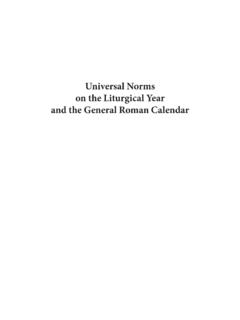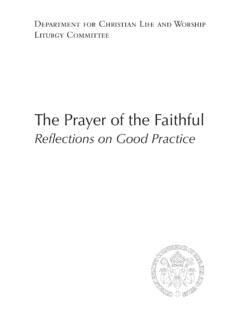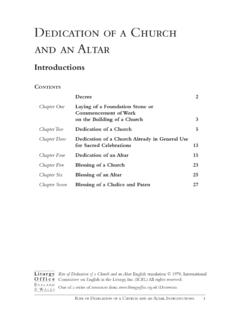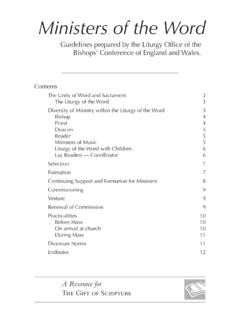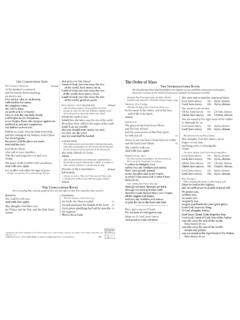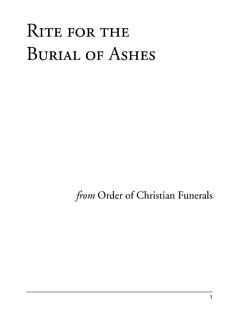Transcription of Department for Christian Life & Worship: Liturgy …
1 1 Department for Christian life & worship : Liturgy CommitteeThe place of silenceSt John Paul II writing in 2004 to mark the 40th anniversary of the Second Vatican Council s document on the Liturgy said:One aspect that we must foster in our communities with greater commitment is the experience of silence. We need silence if we are to accept in our hearts the full resonance of the voice of the Holy Spirit and to unite our personal prayer more closely to the Word of God and the public voice of the Church . In a society that lives at an increasingly frenetic pace, often deafened by noise and confused by the ephemeral, it is vital to rediscover the value of silence.
2 The spread, also outside Christian worship , of practices of meditation that give priority to recollection is not accidental. Why not start daring a specific Let us keep before our eyes the example of Jesus, who rose and went out to a lonely place, and there he prayed (Mk 1: 35). The Liturgy , with its different moments and symbols, cannot ignore desire for silence is a human phenomenon which many today search for. In Do you love me? A guide to Catholic Spirituality the bishops write of the importance of silence:Real silence though is not just an absence of noise. We can be very noisy indeed on the inside even if the outside is quiet.
3 It is also possible to be quiet on the inside while chaos reigns on the outside. This is because silence helps us get in touch with our real selves and opens the path for us to hear the still, small voice of God. Silence is indeed golden. For some of us, however, befriending silence is not easy. It can be difficult to find some silence in a noisy world, especially as it is such a rarity. It can be difficult because we are not used to it and we so easily get distracted. Sometimes we forget that the mind is there to think with. It abhors a vacuum so it is well nigh impossible for it to stop thinking.
4 But we can quieten it and the worst thing we can do with distractions is be distracted by them. Let them go. Do not beat yourself up about them or give them undue attention. What silence does is to help us shift to a different interior space. It opens us up and balances us. So, how can we befriend it and discover the immense value it has?2 St John Paul saw that pastors had a task to educate in prayer and linked this with the promotion of the liturgical life , through discernment and guidance. Part of the role of Liturgy is to instil a taste for prayer. To do so, it will of course take into account the ability of individual believers and their different conditions of age and culture; but in doing so it will not be content with the minimum.
5 3 The Liturgy as the source and summit of the life of the Church is where our silent prayer and reflection leads but also where it is experienced and nurtured. It is one of 1. John Paul II, Spiritus et Sponsa[SS] 132. Catholic Bishops Conference of England and Wales, Do you love me? A guide to Catholic Spirituality, page 413. SS 142the languages of the Liturgy : words and music, gesture and silence, movement, the liturgical colours of the vestments .4 Therefore silence is not a separate part of some celebration but integral to the whole of all celebrations. During liturgical silence all respond in their own way, recollecting themselves, pondering what has been heard, petitioning and praising God in their inmost the silence the Liturgy moves forward as one part flows to the next.
6 For example, a pause for silence after the homily allows people to take the word of God to heart and to prepare a response to it in Silent reflection, such as this, is part of the essential dynamic of participation in the Liturgy :The active participation of the faithful is first of all internal in that their thoughts reflect what they hear, do, and say during the Liturgy . It is also external in that through their outward bearing and gestures they express their inner participation in the Liturgy . The ritual interplay of the internal and external elements of the Liturgy conveys the transcendence and the immanence of the living God whom the assembly Silence in the Celebration of MassThe Roman Missal highlights a number of places in the Mass where silence is to be encouraged.
7 These are considered it should be noted that not all liturgical silence is the same. It will differ in length and purpose according to the part of the celebration. It may be a short moment of recollection, a pause between parts of the Liturgy or it may be a time of praise of God in people s hearts leading to prayer and petition. The two places where the documents suggest the longest silence are after the homily and after the distribution of Holy Communion. At both these points it is expected that all present hold the silent reflection in common. In general, within the Liturgy , where there is silence it is shared by all.
8 There are times when the silence accompanies a liturgical action so that it is what we see that prompts our prayerful response. The different types of silence can be summarised as follows:1. Break Short pause for clarity of structure & flow ( before Liturgy of the Word)2. Pause for Recollection Part of a larger action. ( at the Collect, the pause for prayer following Let us pray . Other places include Penitential Act, at the end of Readings, Preparation for Communion, Prayer after Communion3. Silent attentive: The assembly is silent while something happens:a. listening Readingsb.)
9 Praying Eucharistic Prayer, Collectc. looking Preparation of Gifts4. Second Vatican Council, Sacrosanctum Concilium (SC) 405. Catholic Bishops Conference of England & Wales, Celebrating the Mass (CTM) 916. cf. Lectionary for Mass Introduction (LMI) 287. CTM 54, cf. Musicam Sacram, (MS) 1534. Silent Reflection A more extended period after Homily or after Communion (leading to prayer or praise)Silence in the Introductory RitesThe purpose of the Introductory Rites is to ensure that the faithful, who come together as one, establish communion and dispose themselves to listen the Word of God and to celebrate the Eucharist Penitential ActThere is a brief pause for silence after the opening invitation where the faithful after invited to acknowledge our sins, and so prepare ourselves to celebrate the sacred mysteries.
10 CollectAfter the invitation Let us pray all pray in silence. Everybody observes a brief silence so that they may become aware of being in God s presence and may call to mind their intentions .9 Silence in the Liturgy of the Word By silence and by singing, the people make this divine word their own, and affirm their adherence to it by means of the Profession of Faith; finally, having been nourished by the divine word, the people pour out their petitions by means of the Universal Prayer for the needs of the whole Church and for the salvation of the whole world. 10 The Liturgy of the Word is to be celebrated in such a way as to favour meditation, and so any kind of haste such as hinders recollection is clearly to be avoided.

